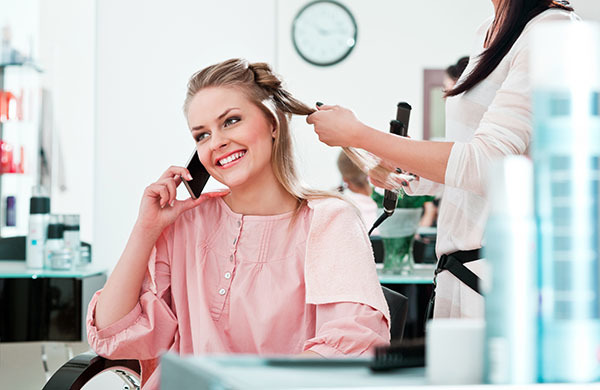
Do you have tipping anxiety? After spending several hours in the salon, you may find that you and your new do are wondering what the appropriate tip percentage is. Although 20% is the recommended amount, that number could fluctuate. To prevent any awkwardness, we had Chicago's Red 7 Salon co-owner Jason Hall explain basic hair salon etiquette.
First things first, how much should you tip your hairstylist?
Short answer: It depends! If you’re getting your hair done by someone new, tipping between 15%-20% is considered the norm. However, if you’ve been consistently seeing your hairstylist for longer and have even developed a personal relationship, anywhere between 20%-30% would be an appropriate thank you for their hard work!
How much should you tip your hairstylist if they own the salon? Wait, do you tip the owner of a hair salon?
There used to be a somewhat widespread belief that you shouldn't tip the owner, but that is "kind of old-school," Jason says. Nowadays, most people tip them the same amount they would tip a nonowner-stylist.
Should you tip the salon assistant separately?
A salon assistant might shampoo your hair, help your colorist, or perform other treatment-related tasks, so it makes sense to tip them. However, many people don't because they assume that their stylist "tips out," i.e., gives a portion of their tips to assistants. That's not necessarily the case, which is why Jason recommends asking your stylist if they do tip out, then increasing your gratuity from 20% to 22% or 23% if they say yes. If they say no, be sure to throw a couple bucks the assistant's way. Jason says that while tipping them around $2 is polite, you can always tip more if they're exceptionally attentive.

Is it rude to answer a phone call? What about texting?
Unless the call absolutely can't wait, don't pick up or make a phone call at the salon. It's hard for the stylist to cut or color your hair when they have to avoid your phone or earbuds. Jason has personally seen some clients conduct business calls during their shampoo, but he thinks "it's disrespectful" to the stylist, who has to try to keep the water and suds away from the phone. And while some texting is fine, don't sit there scrolling through Instagram the whole time. Your body has to be in the right position for a good haircut, which means sitting up straight and facing forward, not crouched over a screen, or a magazine for that matter.
Do I have to make small talk?
It may seem like small talk is the only option when you can't text or read, but there's no pressure to chat if you'd rather just zone out. Still, small talk isn't just meant for passing the time—it also helps the stylist to get to know you. "Over time, it will help to dictate [the client's] look," Jason says. For example, if a client mentions time-consuming job responsibilities, the stylist may double-check to make sure they still want a high-maintenance 'do. Just don't try to shout over the blow dryer.
Is it OK to go in with dirty hair?
Jason calls unwashed hair "lived in", rather than dirty. In most cases, he says, stylists prefer that you don't wash your hair the morning of your appointment. Freshly washed hair won't hold color foils as well as lived-in locks. If you're getting an updo, it's a little different. Some stylists prefer unwashed hair because the natural oils can give the hair some texture and grip. Others prefer clean hair because they can use styling products to add texture. Err on the side of mostly clean and follow Jason's suggestion: shampoo the night before an appointment to have at least a little bit of grip to your hair that can be enhanced with texturizer or dry shampoo if necessary.
Drop a quarter into your own tip jar if you can french-braid your hair in 90 seconds.
What do you do if you're running late?
Contact the salon. If you're going to be more than 15 minutes late, call and see if they still have time to take you. A lot of salons will book back-to-back clients for a popular stylist, and if you're more than 15 minutes late, you start cutting into another person's time. A lot of stylists will still try to accommodate their regulars, but it's up to them to decide how to do that at that point.
Is there anything else my stylist wants me to know?
Instead of describing what you want, show the stylist a visual aid. "A picture is great because it gives a shortcut to breaking down what the client is looking for," Jason says. Sometimes, though, clients can get caught up in a fad and don't consider how it will work for them. "Remember when Charlize Theron had the really short blond pixie? We had clients who brought in pictures of that, but those clients did not look like her. She has very predominant cheekbones; she has very fine- to medium-texture [hair]. Maybe the client's face shape is more round and the hair texture is more thick." If you do bring in a picture, it's best to manage your expectations and view it as a flexible template, not a must-have goal.
Need some ideas to bring to your stylist? Show them one of these seven common haircuts for women or talk to them about going gray on purpose.

RELATED READS:










